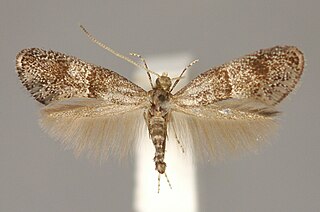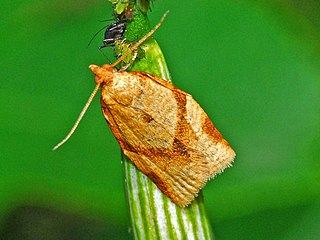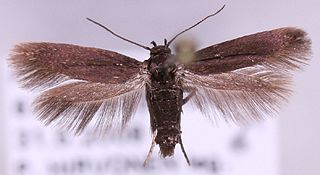
The insects of the beetle family Chrysomelidae are commonly known as leaf beetles, and include over 37,000 species in more than 2,500 genera, making up one of the largest and most commonly encountered of all beetle families. Numerous subfamilies are recognized, but the precise taxonomy and systematics are likely to change with ongoing research.

Science, technology, engineering, and mathematics (STEM) is an umbrella term used to group together the distinct but related technical disciplines of science, technology, engineering, and mathematics. The term is typically used in the context of education policy or curriculum choices in schools. It has implications for workforce development, national security concerns, and immigration policy, with regard to admitting foreign students and tech workers.

Douglasiidae is a small Lepidopteran family including around 28 species of micromoth whose adults are collectively called Douglas moths. The largest genus in the family is Tinagma. They are primarily found in the Palearctic and Nearctic realms. The adults have a 6 to 15 mm wingspan, with a reduced hindwing venation and long fringes. The larvae are leaf miners or borers, primarily in stems and petioles, belonging to Boraginaceae, Labiatae, and Rosaceae.

Stomopteryx is a genus of moths in the family Gelechiidae.

Etiella behrii is a species of moth of the family Pyralidae, occurring sporadically but when present considered a serious pest of agricultural crops throughout parts of Australia.

Clepsis consimilana, the privet tortrix, is a moth of the family Tortricidae.

Bactra venosana, the nutgrass borer or nutsedge borer, is a moth of the family Tortricidae. It was first described by Philipp Christoph Zeller in 1847. Julius von Kennel provides a full description. It has a wide distribution, from southern Europe, North Africa and Asia Minor to India, Sri Lanka, southern China, Malaya, Australia and into the Pacific where it is found on Java, Borneo, the Philippines, Taiwan, Timor, the Solomons, the Carolines and Fiji. It was introduced to Hawaii in 1925 to control nutsedge. It is now found on Kauai, Oahu, Molokai, Maui, Lanai and Hawaii.
Agdistis tamaricis is a moth of the family Pterophoridae found in Africa, Asia and Europe. It was first described by the German entomologist, Philipp Christoph Zeller in 1847.

Crombrugghia distans, also known as the Breckland plume is a moth of the family Pterophoridae found in Africa, Asia and Europe. It was first described by Philipp Christoph Zeller in 1847.

Merrifieldia baliodactylus, also known as the dingy white plume, is a moth of the family Pterophoridae found in most of Europe. It was first described by the German entomologist, Philipp Christoph Zeller in 1841.

Elachista disemiella is a moth of the family Elachistidae. It is found in France, on the Iberian Peninsula and in Italy and Hungary.

Elachista contaminatella is a moth of the family Elachistidae that is found from France, Austria and Slovakia to the Iberian Peninsula, Sardinia and Sicily. It is also found in Bulgaria and Russia.

Elachista chrysodesmella is a moth of the family Elachistidae. It is found from Sweden to the Iberian Peninsula, Italy and Romania and from France to Russia and Ukraine.

Stomopteryx schizogynae is a moth of the family Gelechiidae. It is found on the Canary Islands.
Cyclophora suppunctaria is a moth in the family Geometridae. It was described by Philipp Christoph Zeller in 1847. It is found in Spain, Andorra, France, Austria, Switzerland, Italy, Slovakia, Albania, Slovenia, Croatia, Bulgaria, Romania, Hungary, North Macedonia, Greece, on Sardinia, Corsica, Sicily and Crete, as well as in Tunisia, Turkey, Russia and Ukraine.
Dichomeris lamprostoma is a moth of the family Gelechiidae. It was described by Zeller in 1847. It is found in France and Spain, as well as on Sardinia, Sicily, Crete, Cyprus and the Canary Islands. It has also been recorded from Kenya and the United Arab Emirates.

Scythris potentillella is a moth of the family Scythrididae first described by the German entomologist Philipp Christoph Zeller in 1847. It is found in Asia Minor and Europe.
Stomopteryx remissella is a moth of the family Gelechiidae. It was described by Philipp Christoph Zeller in 1847. It is found in most of Europe.

Steniini is a tribe of the species-rich subfamily Spilomelinae in the pyraloid moth family Crambidae. The tribe was erected by Achille Guenée in 1854.














